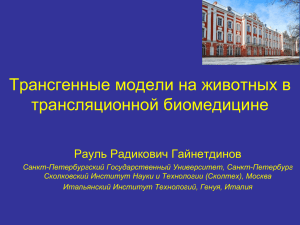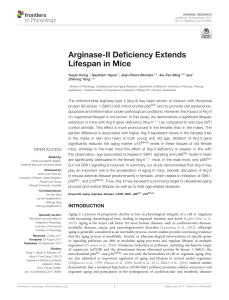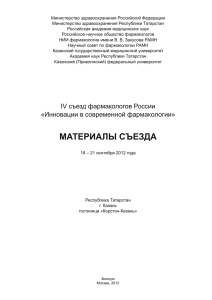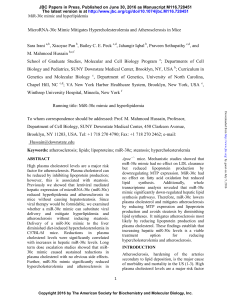Gender features of clinical course of experimental allergic
advertisement

Международный научно-исследовательский журнал ▪ № 2 (44) ▪ Часть 2 ▪Февраль DOI: 10.18454/IRJ.2016.44.141 Предтеченская Е.В.1, Сорокина И.В.2, Заиграев В.Ю.3 1 Доктор медицинских наук, профессор, Новосибирский Национальный Исследовательский Государственный Университет (НГУ), 2доктор биологических наук, Новосибирский Национальный Исследовательский Государственный Университет (НГУ), 3ORCID:0000-0002-2183-6486, Новосибирский Национальный Исследовательский Государственный Университет (НГУ) ГЕНДЕРНЫЕ ОСОБЕННОСТИ КЛИНИЧЕСКОГО ТЕЧЕНИЯ ЭКСПЕРИМЕНТАЛЬНОГО АЛЛЕРГИЧЕСКОГО ЭНЦЕФАЛОМИЕЛИТА У ЛАБОРАТОРНЫХ ЖИВОТНЫХ Аннотация Рассеянный склероз (РС) – хроническое прогрессирующее аутоиммунное демиелинизирующее заболевание центральной нервной системы. Существуют значительные различия течения РС у больных разного пола, что вероятно связано с особенностями рецепции половых стероидов и/или их синтеза в ЦНС у мужчин и женщин. Мы обнаружили некоторые различия в клиническом течении модели РС -экспериментального аллергического энцефаломиелита у мышей разного пола и кастрированных животных (линии C57BL/6). В оценке использованы тесты «вращающийся стержень» и «открытое поле». Ключевые слова: рассеянный склероз, экспериментальный аллергический энцефаломиелит, гендерные особенности, C57BL/6. Predtechenskaya E.V.1, Sorokina I.V.2, Zaigraev V.Yu.3 MD, professor, National Research University Novosibirsk State University (NSU), 2PhD in Biology, National Research University Novosibirsk State University (NSU), 3ORCID:0000-0002-2183-6486, National Research University Novosibirsk State University (NSU) GENDER FEATURES OF CLINICAL COURSE OF EXPERIMENTAL ALLERGIC ENCEPHALOMYELITIS IN LABORATORY ANIMALS Abstract Multiple sclerosis (MS) is a chronic inflammatory demyelinating disease of central nervous system (CNS). There are great differences in course of MS in patients with different sexes, that may be associated with variations steroids synthesis and/or reception in CNS in males and females. We found some differences in clinical course of experimental allergic encephalomyelitis (mouse model for MS) between mice with different sexes, including castrated males. In estimation of clinical severity we have also used Rotarod Performance Test (RPT) and Open Field Test (OFT). Keywords: multiple sclerosis, experimental allergic encephalomyelitis, gender features, C57BL/6 1 I ntroduction Multiple sclerosis (MS) is a chronic inflammatory demyelinating disease of central nervous system (CNS). MS incidence is 3,6 per 100 000 in females and 2 per in males. [1, 2] Pathogenesis of brain tissue injury in MS lesions is not completely known. For now, 4 pathohistological patterns are described. They reflect different types of MS course and their pathogenesis may be different. [3] There is substantial difference in the course of MS between patients with different sex. Thus, the female-to-male ratio in MS incidence is 2,3 and increases for 6% per every 5 years [2] Аge of the MS debut is younger in females, also females usually have relapsing-remitting course of the disease unlike males who have primaryprogressive course. [1, 4] There is widely described protective role of pregnancy in MS. The explanation for this phenomenon is the neuroprotective role of high-leveled pregnancy steroid hormones, particularly estriol. [10] So, these gender features suggests that steroids have great influence for course of the MS. There is some studies on the treatment of MS using sex steroids. [5, 6] Experimental autoimmune (allergic) encephalomyelitis (EAE) is a most commonly used animal model for MS. It can be induced on various animal species, particularly in the mouse by immunization using myelin basic protein (MBP), proteolipid protein (PLP) or myelin oligodendrocyte glycoprotein (MOG). EAE pathogenesis is based on T-cell mediated immune inflammation that substantially comply with pathogenesis of MS. [3, 7] Different mouse strains in combination with different antigens can cause or remitting-relapsic or monophasic or chronic course of EAE. [8] Course of MOG35-55-induced EAE in C57BL/6 mice should be monophasic and self-limited. [9] So, EAE is a suitable model for studying of the demyelination and spontaneous remyelination and factors that can influence on it. The purpose of our study is evaluation of clinical features of clinical course of EAE in female, male and castrated male C57BL/6 mice. Features of clinical course was evaluated by three parameters: Day of the disease debut Clinical phase duration Total severity degree Methods ANIMALS Male, female, and castrated male C57BL/6 mice (n=48, 5-7 weeks of age, 20-28 g of weight) were raised in Novosibirsk institute of Organic Chemistry, Siberian Branch of the Russian Academy of Science (Novosibirsk, Russia). All experimental procedures were approved by the Institutional Animal Care Committee. 12 days before experiment starts, 16 male mice were castrated. Animals were separated for 3 groups: males, castrati, females (n=16 in each; 10 experimental mice and 6 intact for control). EAE INDUCTION Induction of EAE was performed using standard protocol. [8] For immunization, emulsion containing 100μl 2mg/ml MOG35–55 peptide (InnovaGen) and 100μl of complete Freund’s adjuvant (CFA) containing 0.4 mg of heat-inactivated Mycobacterium tuberculosis (H37Ra; Difco Laboratories) were purified. Injection of antigen/CFA emulsion was made 72 Международный научно-исследовательский журнал ▪ № 2 (44) ▪ Часть 2 ▪Февраль subcutaneously into withers and two different sites on each hind flank. Also each mouse received 200 ng of pertussis toxin (Sigma-Aldrich) by intraperitoneal injection on days 0 and 2 post-immunization. Mice state was observed every day and was described in daily diaries of clinical severity. Total duration of observation was 35 days. Clinical severity of EAE was determined by 10-point scale [10]: 0 - no clinical signs; 1 - partially limp tail; 2 - paralyzed tail; 3 - hind limb paresis, uncoordinated movement; 4 - one hind limb paralyzed; 5 - both hind limbs paralyzed; 6 - hind limbs paralyzed, weakness in forelimbs; 7 - hind limbs paralyzed, one forelimb paralyzed; 8 - hind limbs paralyzed, both forelimbs paralyzed; 9 - moribund; 10 - death. INSTRUMENTAL TESTS To explore locomotor activity and coordination, we used Rotarod Performance Test (RPT). [11] Count of falls for 2 minutes and time to first fall were measured. Test was performed on day 10, 12, 14 and 24. Also we performed Open Field Test (OFT) using the TRU SCAN Activity Monitoring System (TRUSCAN) to examine locomotor and explorative activity of mice. Each mouse was placed in the arena for 6 minutes. Test was performed on day 10, 14, 21, 26 and 33. TRUSCAN made it possible to measure a lot of parameters of vertical and horizontal locomotor activity. There is special interest in parameters “nose poke entries” (count of entries of nose inserting into special holes, located on arena for 6 minutes) and “nose poke time” (the time spent on “nose-poking” for the same 6 minutes). These parameters reflects exploratory activity in the mouse. Both tests were firstly performed until tail and limps paresis appeared (before clinical debut of EAE); mice having clinical score 1 and more were excluded from these tests. Statistical process For statistical analysis we used GNU R (R Core Team, 2016) and Rstudio 0.99.489 (RStudio Team, 2015). The data are expressed as mean ± standard deviation ( xˉ ± sd). As normality tests were positive, we used ANOVA and Tukey's range test. P<0.05 was regarded as statistically significant. Results CLINICAL GRADUATION Using selected parameters: day of the debut, clinical phase duration and mean total clinical severity score, we have shown some differences in clinical graduation of EAE between male, female and castrate mice. Read more in table 1. Group Table 1 – Clinical graduation of EAE in different sexes of C57/BL6 mice Males Castrati Females Morbidity 60% 60% 70% Day of the debut Day 10 Day 10 Day 12 Relapse duration 7 days 9 days 6 days Mean total score 2±1,9 points 2,5±2,1 points 2,1±2,0 points Thus, we have detected following regularities: 1. Male and castrate mice had earlier debut of clinical manifestation (on day 10); females showed deferred onset of the disease. 2. There was the shortest duration of the clinical phase in females (6 days) unlike the longest clinical phase at castrates (9 days) 3. The highest mean total clinical score was observed in castrati group; males and females showed similar mean total score. 4. Interestingly, two females had signs of a second relapse after remission, despite declared monophasic course of EAE in this model. INSTRUMENTAL TESTS IN PRECLINICAL PERIOD Assessment of RPT has begun in preclinical period. Falls count in experimental males group was 3 unlike 0,2 in control males group. In castrati and females, differences between experimental and control groups had no significant differences. Also males showed significantly greater count of falls than females and castrati. This observations suggests that preclinical evidence of the disease in males detectable in tests and there is a lesion of the motor and coordination systems, so EAE develops subacutely. Females haven’t got any signs neither in provocation tests, nor in clinical graduation. First clinical signs in females were discovered on day 12. Open field test, which attests about exploratory activity of mice, showed trend towards more activity in females than males and castrati. Experimental groups aren’t significantly differ from control. However, trend towards exploratory activity in females existing between control groups increased to significantly difference in experimental groups. More details in table 2. 73 Международный научно-исследовательский журнал ▪ № 2 (44) ▪ Часть 2 ▪Февраль Fig. 1 – Falls from rotarod in preclinical stage Group Table 2 – Results of RPT an OFT in preclinical stage Falls from rotarod Nose poke entries (OFT) Nose poke time, sec (OFT) Males (control) 0.17±0.41 2.67±1.5 6.833±2.994 Males 3±2.93* 2.2±3.0 4.6±4.03 Castrati (control) 0.33±0.52 4.67±4.59 10.67±8.29 Castrati 0.57±0.79 2.8±1.23 5.4±2.22 Females (control) 0.5±1.225 9±6.99** 16.167±10.998 Females 0.83±1.17 9.5±4.767 * p<0.05 compared with other groups **p<0.05 compared with males and castrati 21.1±6.66** Fig. 2 – Nose poke entries count in OFT 74 Международный научно-исследовательский журнал ▪ № 2 (44) ▪ Часть 2 ▪Февраль Fig. 3 – Nose poke time in OFT Conclusion Exploration of features of clinical course of the MOG-induced EAE in C57BL/6 mice of different sexes showed differences in debut term, clinical severity and duration of clinical phase of EAE. Male and castrate mice had early debut of paresis and preclinical signs in motor and coordinatory tests. Castrati also had the longest duration of clinical phase and the highest mean total score of clinical severity. Females revealed deferred debut, short clinical phase and acute onset of the disease without preclinical coordinator system implication. As result we can say that mice castrated 12 days before experiment starts was the most susceptible for EAE and had the most severity, longest duration of clinical phase and subacute course of the disease. Similar regularities were discovered in males. This evidence accords to features in course of MS in males and females and demonstrate the great role of sex steroids in pathogenesis of these diseases. References 1. Céline Jobin. Gender issues in multiple sclerosis: an update // Womens Health (Lond Engl). 2010 Nov;6(6):797-820. 2. Alonso A, Hernan MA. Temporal trends in the incidence of multiple sclerosis: a systematic review // Neurology 71(2), 129–135 (2008). 3. Lucchinetti C. Heterogenity of multiple sclerosis lesions: implications for the pathogenesis of demyelination // Ann Neurol 47: 707 – 717. 4. Coyle PK: Gender issues // Neurol. Clin. 23(1), 39–60, v–vi (2005). 5. Kim S. Estriol ameliorates autoimmune demyelinating disease: implications for multiple sclerosis // Neurology. 1999 Apr 12; 52(6):1230-8. 6. Schwendimann RN, Alekseeva N. Gender issues in multiple sclerosis // Int Rev Neurobiol. 2007;79:377-92. 7. Gold R, Linington C, Lassmann H. Understanding pathogenesis and therapy of multiple sclerosis via animal models: 70 years of merits and culprits in experimental autoimmune encephalomyelitis research // Brain. 2006 Aug;129(Pt 8):1953-71. 8. Stephen D. Miller, William J. Karpus, Todd Scott Davidson. Experimental Autoimmune Encephalomyelitis in the Mouse // Curr Protoc Immunol. 2007 May; CHAPTER: Unit–15.1. 9. Bittner, S., Afzali, A.M., Wiendl, H., Meuth, S.G. Myelin Oligodendrocyte Glycoprotein (MOG35-55) Induced Experimental Autoimmune Encephalomyelitis (EAE) in C57BL/6 Mice // Journal of Visualised Experiment (86), e51275 (2014). 10. Terayama, R. Neuropsin promotes oligodendrocyte death, demyelination and axonal degeneration after spinal cord injury // Neuroscience 148, 175–187. 11. Seema Tiwari-Woodruff. Differential neuroprotective and antiinflammatory effects of estrogen receptor (ER)α and ERβ ligand treatment // Proc Natl Acad Sci U S A. 2007 Sep 11; 104(37): 14813–14818. 75



